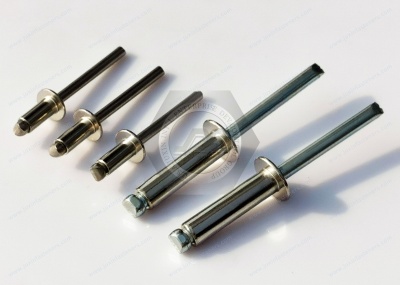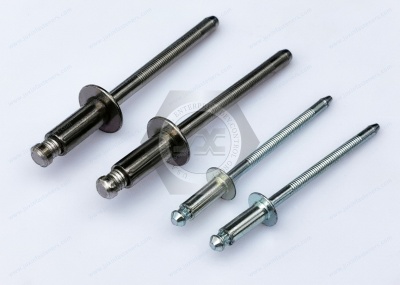Call Us
+86 136 6007 9809
Call Us
+86 136 6007 9809
Jan. 13, 2024
Types of rivets and solutions in the industry
Standard rivets are manufactured from special steel wires that are forged, hardened, and tempered. They offer optimum riveting performance in various applications and unique materials.
1. Austenitic stainless steel rivets - used for riveting stainless steel plates with low hardness;
2. Martensitic stainless steel rivets - used to rivet high-hardness stainless steel plates that cannot be connected with austenitic stainless steel rivets;
3. Copper rivets - for riveting special plates, such as copper, brass, and plastic plates;
4. Aluminum rivets are used to rivet the lower hardness of aluminum sheets.
Rivet hardness rivets are produced at different hardness levels to meet the riveting requirements of other groups of riveted plates—generally, the rivet's hardness increases with the sheet's thickness and hardness. Customers can always contact Juxin Fasteners to determine the applicable rivet hardness and shape.
Various types of rivets and their uses: rivets are usually used as consumables for riveting operations and are commonly used in the work of a rivet gun. They can be categorized into blind rivets, semi-circular head rivets, strike core rivets, tubular rivets, hollow rivets, and countersunk head rivets. The most commonly used rivets are semi-circular head rivets, mainly for more significant lateral load riveting occasions.
Striking core rivets is another type of single-sided riveting rivets, riveting with a hammer to hit the head of the rivet to reveal the core so that it is flush with the end of the nail head; that is, to complete the riveting operation, it is very convenient, especially for the inconvenience of using ordinary rivets (must be from both sides of the riveted) or core-pulling rivets (the lack of riveting gun) riveting occasions. Usually applied flat round head break mandrel rivets, countersunk head break mandrel rivets for the surface need smooth riveting occasions. Blind rivets are a class of single-sided riveting with rivets, but the use of specialized tools rivet guns (manual, electric, of the action) for riveting. These rivets are particularly suitable for the inconvenience of using ordinary rivets (to be riveted from both sides). It is widely used in construction, automobiles, ships, airplanes, machines, electrical appliances, furniture, and other products on riveting occasions. Open-end blind rivets with flat round heads are the most widely used; countersunk head blind rivets are suitable for riveting occasions that require smooth performance, and closed-end blind rivets are ideal for riveting occasions that require smooth performance.
Closed-end blind rivets suit riveting occasions requiring higher loads and specific sealing performance.
18-8 Stainless Steel Domed Head Blind Rivets. Made from 18-8 stainless steel, these blind rivets create a firm hold even in wet areas. The domed head gives your project a finished appearance.
Use these blind rivets to fasten hinges, shelves, or other assemblies where you can only access one side. You can also use them to join materials that are difficult to weld or solder. The back of the rivet deforms during installation, creating a permanent hold that won't loosen from vibration. It also means you can't overtighten or strip them.
To install these rivets, you'll need a blind rivet tool (sold separately). Be sure to pick a tool compatible with your rivet's diameter and material. For more information on installing rivets, see About Installing Blind Rivets.
Blind rivets that meet ISO 15983 (formerly DIN 7337) comply with international standards for blind rivet dimensions. Those that meet IFI 114 comply with industry standards.
316 Stainless Steel Domed Head Blind Rivets, More corrosion resistant than 18-8 stainless steel rivets; these 316 stainless steel rivets have excellent resistance to chemicals and salt water. They join material when you only have access to one side. The low-profile domed head creates a finished appearance.
The combined thickness of the material must fall within the rivet's material thickness range. Shear strength is the force it takes to break a rivet from the side, and tensile strength is the pull a rivet can withstand without breaking. Joint strength is also affected by rivet spacing and hole size.


A blind rivet tool (sold separately) with a nosepiece that matches the rivet's diameter is required for installation.
1. Stainless steel blind rivets high-temperature resistance: Because the hardness of stainless steel itself is relatively strong, after the production of rivets, it has a robust anti-oxidation ability, and at high temperatures, also able to work usually, will not be subjected to high temperatures too much interference, stainless steel blind rivets in the manufacture of passivation at the same time after the high-temperature resistance is more substantial.
2. The physical properties of stainless steel blind rivets have a relatively high rate of electrical cathode and carbon steel wire compared to; we can see that the electrical cathode rate of stainless steel blind rivets is five times higher than that of carbon steel. There is an expansion coefficient in the standard parts; after testing, we know that if the temperature is high, then the expansion coefficient of stainless steel blind rivets will have an inevitable increase.
3. Stainless steel blind rivets' force capacity: stainless steel blind rivets can withstand the load and are relatively strong, although not strong bolts compared to each other, but also meet the needs of ordinary people.
4. Mechanical properties of stainless steel blind rivets. Regarding the mechanical properties, it can be known that many have a great relationship with stainless steel wire. Juxin Fasteners, mainly 304 or 316 wire or plate manufacturing rivets, will not rust and have high corrosion resistance and high tensile shear; these are followed by stainless steel, which has a great relationship with the nature of the rivets, with the continuous development of the blind rivets, these mechanical properties are also with the Become stronger and stronger.
18-8 Stainless Steel Wide-Thickness-Range Domed Head Blind Rivets,18-8 stainless steel has good corrosion resistance and may be mildly magnetic. These rivets grip a much more comprehensive range of material thicknesses than standard blind rivets. Use to join material when you only have access to one side. The low-profile domed head creates a finished appearance.
The combined thickness of the material must fall within the rivet's material thickness range. Shear strength is the force it takes to break a rivet from the side, and tensile strength is the pull a rivet can withstand without breaking. Joint strength is also affected by rivet spacing and hole size.
A blind rivet tool (sold separately) with a nosepiece that matches the rivet's diameter is required for installation.
If you are looking for high-quality blind stainless steel rivet fasteners or technical support for structural design, please get in touch with me. Thanks.Email:adelajonly@gmail.com
Website: https://www.juxinfasteners.com
Contact Us
Tel.:
+86 020 8621 0320
+86 020 3121 6067
Technical Support:
Navigation
SEND INQUIREY